Group Projects: Teamwork makes the dream work
23 March 2020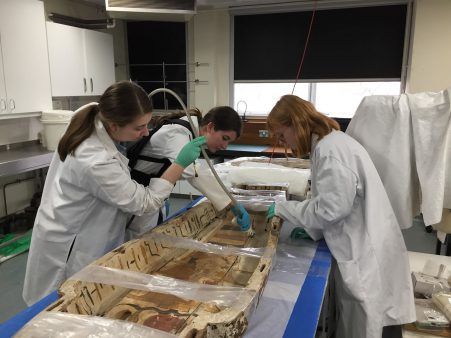
Some objects that arrive at the university lab are too large or complex for a single person to work on, so their responsibility is given to a ‘project manager’, usually a final-year undergraduate or master’s student. The manager devises a treatment strategy to be carried out with the assistance of a small team. Many of these objects have several project managers and teams over successive generations of students, each focusing on small steps within a long-term conservation process.
Recently, I asked the 2020 group project managers to tell me a little about the current goals and direction for their objects. The lab is unfortunately closed due to the ongoing COVID-19 pandemic, so treatments are currently at a standstill. These reports are therefore a little out of date. However, I felt it was appropriate to share them now, to highlight the hard work of both the project managers and their teams over this past academic term.
Egyptian coffin base (Egypt Centre, Swansea)
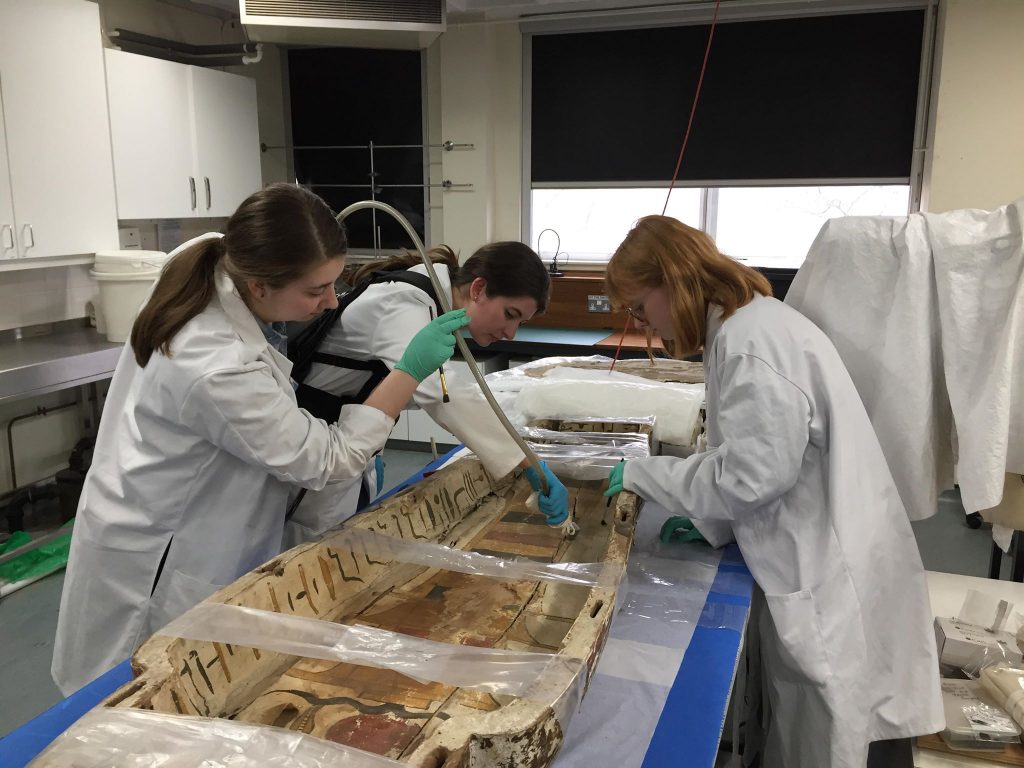
Ellie cleaning the base, assisted by team members Gaby and Martha 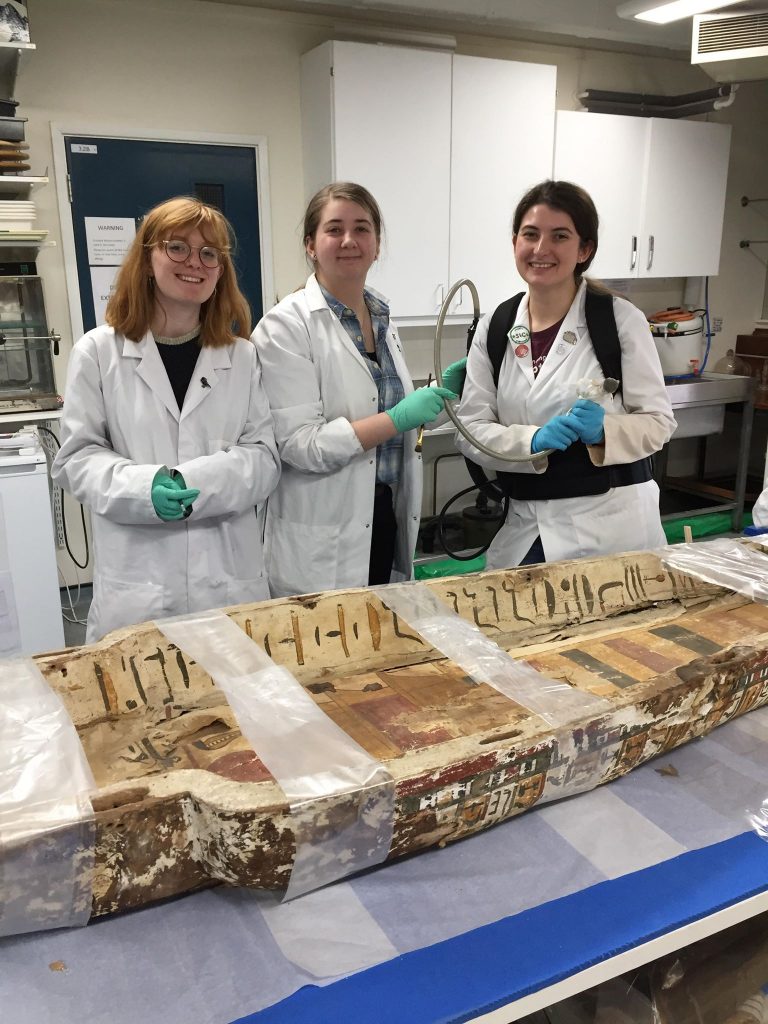
Say cheese!
This Egyptian coffin is from the 26th Dynasty (approximately 650 B.C.) and had two named owners, Ankhpakhred and Djedhor. It was found with the remains of a female mummy inside. Conservation of the coffin lid has been completed by previous years’ students. This year we are beginning the conservation of the coffin base. The base is structurally unstable and is currently held together with straps (this has partially been caused by two broken dowels). Parts of the decoration (cartonnage) have come away from the surface and the entire coffin is covered in dirt and dust. The objectives for this year are to clean the surface (using soft brushes and the museum-vacuum), repair the side which has broken dowels (reattaching it to the coffin so that it does not need to be held together with straps), to consolidate and re-adhere the areas of cartonnage back onto the coffin surface and finally to turn the coffin base over so the underside can be fully investigated.
We have completed the surface clean of the coffin base and are preparing to replace the dowels. We are in close contact with Dr Ken Griffin at the Egypt Centre in Swansea, with regards to the treatment of the base.
Ellie Evans
Empire Games model, a.k.a. George (Museum of Cardiff)
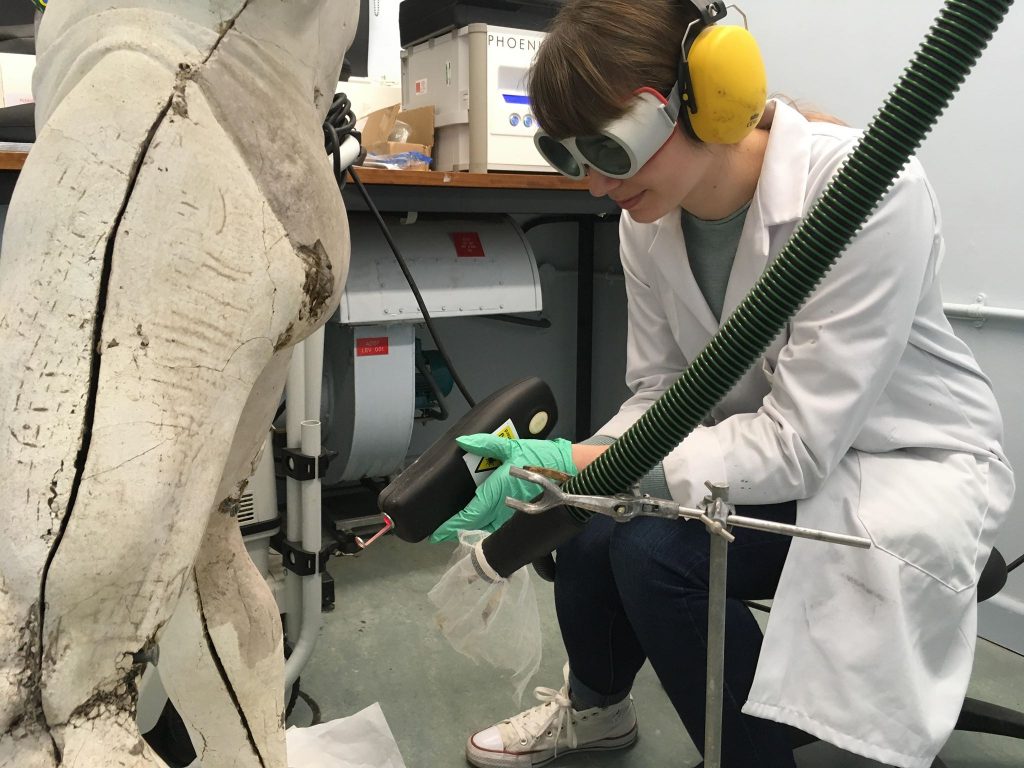
Team member Katie laser cleaning George 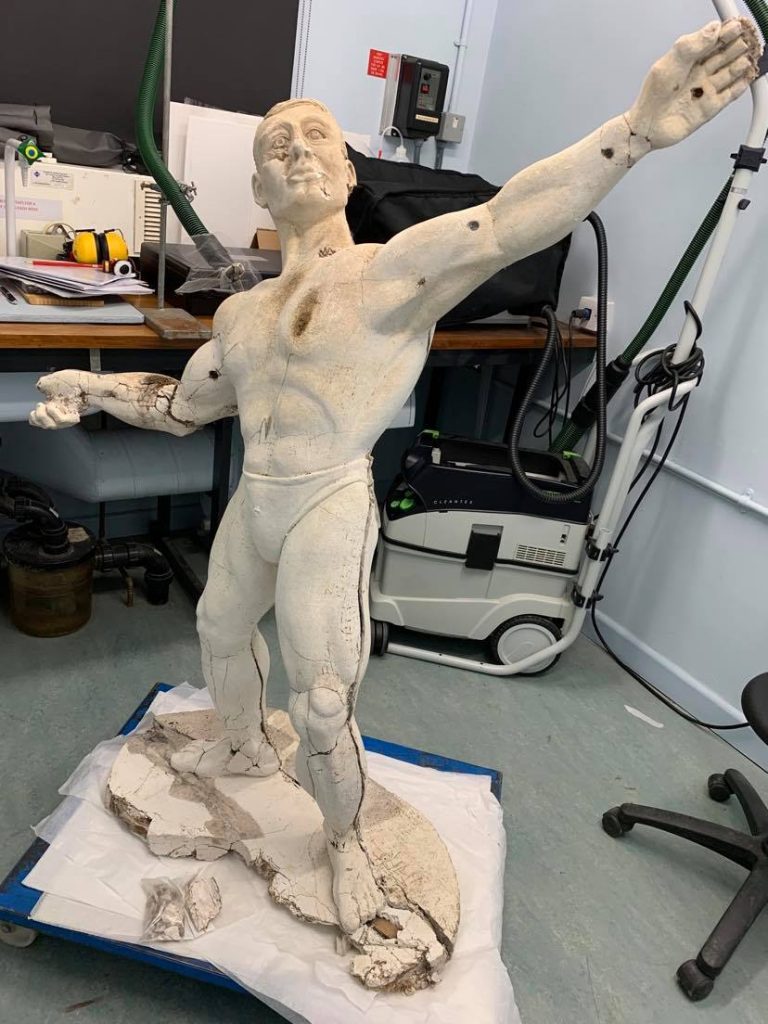
Before Usain Bolt, there was George…
A dedicated core team spent dozens of hours zapping with the Lynton laser this term, and, as a result, George stands proud, free of layers of dust and grime that once dulled his surface. George strutted his new look on CU Conservation’s social media pages, and was featured on the cheeky @museumbums Twitter profile. Now, the co-managers of the project focus on strengthening George’s Achilles heels. We’ll be investigating techniques that provide support from the inside where George’s internal wooden frame is shattered. Think: expanding foam.
Madeline McLeod
Waterlogged treenails (Newport Medieval Ship)
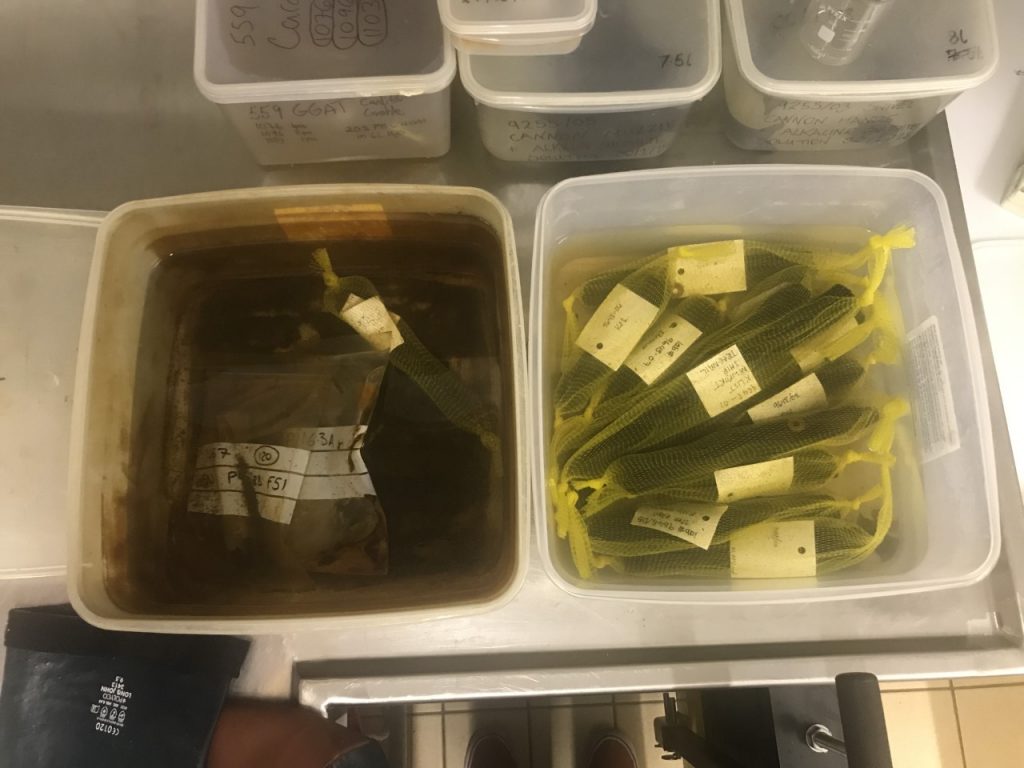
The oak treenails form part of the ship assemblage that was excavated from the River Usk, Newport in 2002. The treatment aims to remove water in the structure, replacing it with polyethylene glycol (PEG) 400 and 4000, a chemical that acts as a bulking agent within the cells. The water is then removed using the vacuum freeze dryer. This will enable them to be used for handling and possibly within the reconstruction of the ship’s timbers.
To date, the treenails that we are working on have been measured and visual observations recorded using photography and spreadsheets. Paintbrushes were then used to remove loosely attached dirt while the treenails were immersed in water. In order to make sure the correct amount of PEG is used, they are weighed and the PEGCON software used to calculate the concentrations required. In November 2019, I visited the current project site and spoke with the volunteers about the future use of the treenails. This insight has helped guide my treatment plan.
Katherine List
St Tydfil statue (Cyfarthfa Castle)
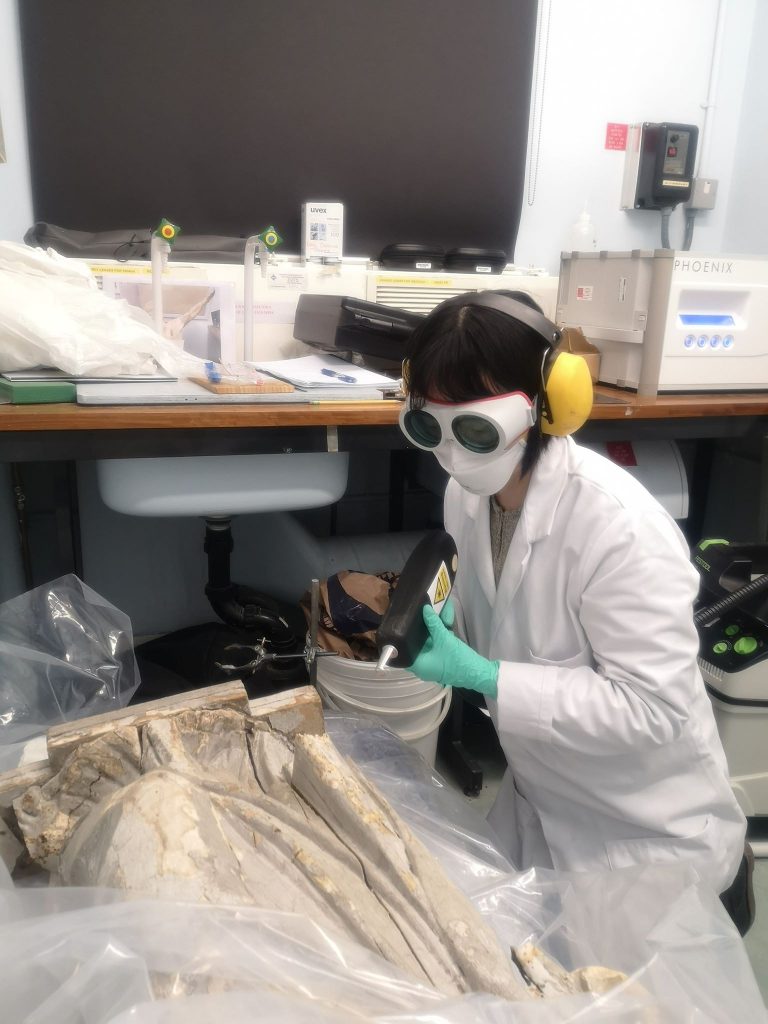
The statue of St. Tydfil from Cyfarthfa Castle Museum and Art Gallery was originally placed outside of the museum. Due to weathering and pest infestation, the wood statue had suffered woodworm damage, structure distortion and paint loss. A previous project conducted by the Cardiff conservation students in 2014 studied the wood substrate and paint layer, and tested several consolidation and cleaning method. The statue was treated with pesticide and the paint consolidated. The unexpected finding of a new wormhole triggered a new round of studies in 2018. The new project aims to monitor storage conditions, figure out the possible cause of pest infestation and terminate it. Laser cleaning is also conducted to the paint surface in order to achieve an uniform look of the mottled statue.
Kongqing Ji
Archaeological stained glass (Dominican Blackfriary in Trim, Co. Meath)
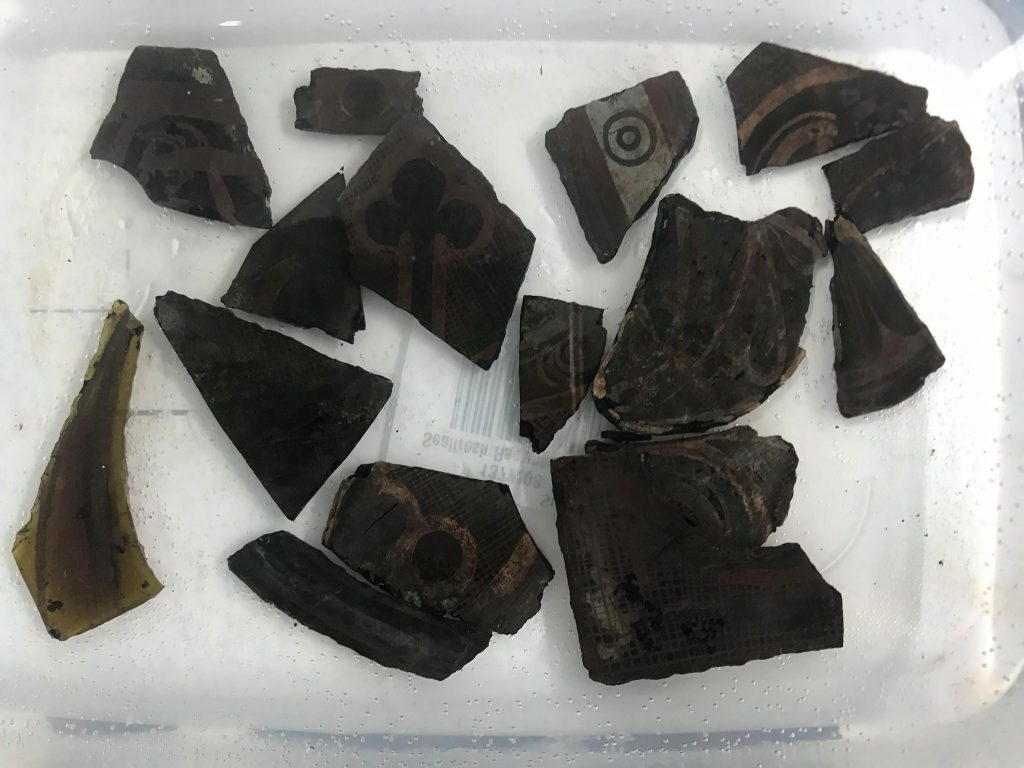
This year, I took over the project management of Irish archaeological stained glass from the Dominican Blackfriary in Trim, Co. Meath. The Friary was founded by Geoffrey de Geneville in 1263. In 1291 the Friary was used as a meeting place for Irish bishops and in 1446 as a location for Parliamentary meetings which indicates the high status of the Friary. The Friary was suppressed by Henry VIII in 1542 but it was during the 1750’s that the stone was taken down for building works. The glass itself is one of the more significant finds from the excavation, with some pieces still within their lead cames. They feature both cross-hatching patterns, indicative of the 13th century and floral patterns, of the 15th century. This project has been ongoing over several years and still won’t be completed this year! The glass comes from a waterlogged environment and so the previous treatment had been to place the glass fragments into increasing concentrations of IMS and then consolidate with 5% Paraloid B72 in acetone. However, after testing, the glass was found to be stable enough that it can be air-dried with a small percentage of pieces needing consolidation.
Ellie Sweetnam
Cannon (Porthcawl Museum)
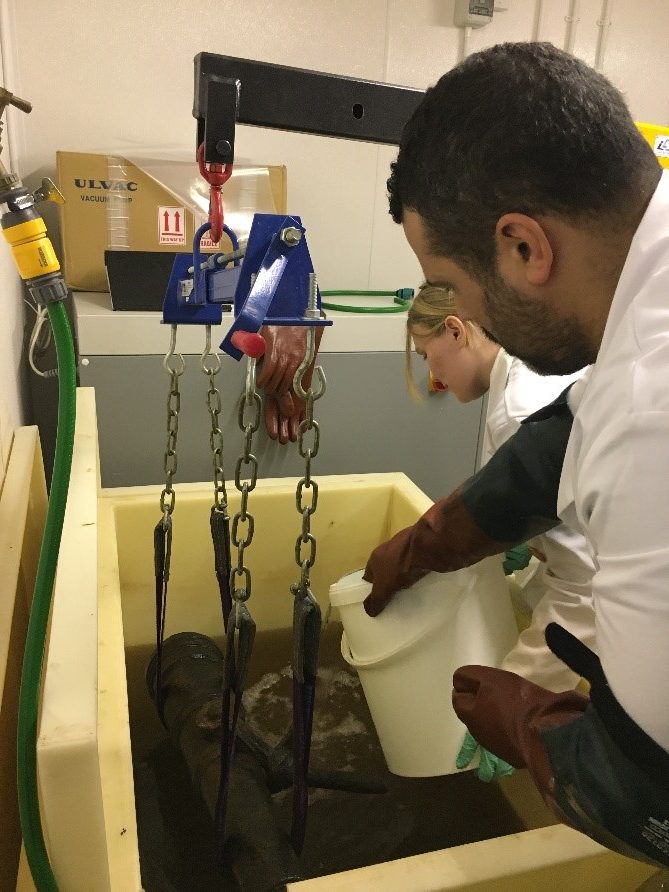
Our swivel cannon from Porthcawl, Wales has been in treatment with us for a few years now and recently myself and my team member Angelo have taken a large step in its ongoing treatment. Currently the cannon is in desalination, an Alkaline Sulphite solution specifically, to remove corrosion causing chlorides in the cannon’s structure from its time in the saltwater. The solution was recently topped up to keep the cannon covered while we work on preparing to neutralize and replace the solution in the spring. Alongside the swivel cannon are a cannon muzzle and swivel cannon handle which are also in desalination. These are much further along and could be finished up within the next year or two.
Olivia Haslam
Egyptian textile (Cyfarthfa Castle)
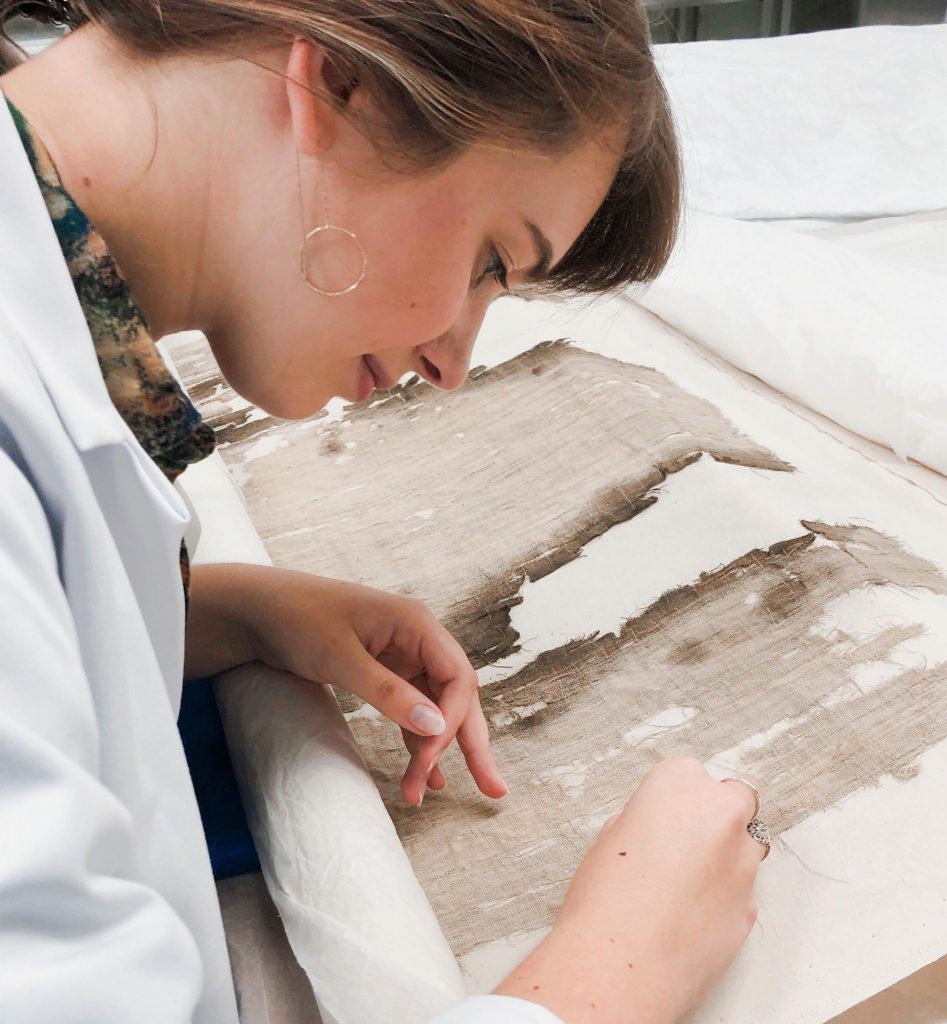
A group of five students are currently working on an ancient Egyptian textile from Cyfarthfa Castle under the guidance of a second year masters student. The linen is thought to be a mummy cloth created 2000-4000 years ago and has forged hieroglyphs from the late 19th or early 20th century meant to increase its value. The textile has been carefully vacuumed and humidified, and the project team is currently sewing the textile to a support fabric using an almost invisible thread called Stablitex to help prevent further damage and loss.
Katie Linder
I hope you’ve enjoyed this short update on this year’s group projects. We’re looking forward to being able to resume work sometime later on in the year.
- March 2024 (1)
- December 2023 (1)
- November 2023 (2)
- March 2023 (2)
- January 2023 (6)
- November 2022 (1)
- October 2022 (1)
- June 2022 (6)
- January 2022 (8)
- March 2021 (2)
- January 2021 (3)
- June 2020 (1)
- May 2020 (1)
- April 2020 (1)
- March 2020 (4)
- February 2020 (3)
- January 2020 (5)
- November 2019 (1)
- October 2019 (1)
- June 2019 (1)
- April 2019 (2)
- March 2019 (1)
- January 2019 (1)
- August 2018 (2)
- July 2018 (5)
- June 2018 (2)
- May 2018 (3)
- March 2018 (1)
- February 2018 (3)
- January 2018 (1)
- December 2017 (1)
- October 2017 (4)
- September 2017 (1)
- August 2017 (2)
- July 2017 (1)
- June 2017 (3)
- May 2017 (1)
- March 2017 (2)
- February 2017 (1)
- January 2017 (5)
- December 2016 (2)
- November 2016 (2)
- June 2016 (1)
- March 2016 (1)
- December 2015 (1)
- July 2014 (1)
- February 2014 (1)
- January 2014 (4)